HOME
Take the time it takes – The Natural Horseman
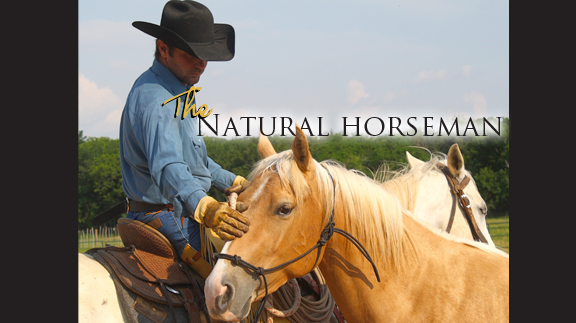
By Steve Stevens
How many minutes is your life worth? If I told you fifteen minutes of groundwork before you ride would guarantee that you would be safe from harm or injury, how many of you would do it? Well, no one can guarantee you anything in this life except that you are alive or dead. What I can do is put things very much in your favor when you ride your horse. I have heard these stories and tell me if they sound familiar. “I just don’t know what happened. He never did that before. I never saw it coming. I can’t believe he bucked with me” or “I have ridden him in parades, and then one day out on the trail, he ran off at nothing.” Over the years of working with multiple cases of these horses I have found four things. 1. The horse wasn’t trained nearly as well as the owner thought. 2. The owner’s riding level didn’t match the ability of the horse. 3. The horse was fresh and not warmed up correctly. 4. There was actually something physically wrong with the horse that the owner wasn’t aware of.
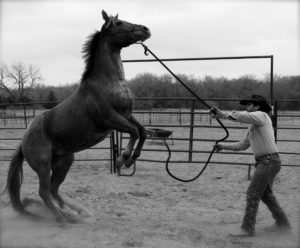
When horses are fresh, they can get overly reactive, so it is important to work this out before we ride them. (Photo by Amanda Stevens)
I want to say this in the most respectful way. I am tired of hearing about people getting hurt on horses when there was no reason for it. At the end of the day, the horse pays for this lack of attention after he hurts someone by being punished or sent down the road to another person or a sale. Sometimes the owner doesn’t want to get rid of the horse but lives in fear of the horse, and the horse is left with not much attention. I think the most important part to this is to understand that the horse is not a machine that we just turn the key and expect it to do what we want. Horses are living, breathing, thinking creatures that have emotions just like us of fear, joy and sadness. They can feel pain and they can feel healthy and strong.
They can get confident or feel insecure. They are also a prey animal that has survived a million years fleeing when it gets scared. So when anyone expects the horse to never have any of these emotions when dealing with them, they will be set up for failure, even with the brokest of broke horses. The worst wrecks are when people are riding the horse they trust the most, because they give them the benefit of the doubt. They don’t warm them up. They ask more of him than is necessary. Often they get overly confident with their horse and put them in situations they are not prepared for. Once you have had an accident or scare on your horse, please truthfully ask yourself these questions. 1. Did you do any groundwork? Most importantly, did you watch your horse walk, trot and canter quietly (the canter is the one gait that can’t be avoided) on a lunge line or in a contained area with the saddle on? 2. Do you lope your horse on a regular basis? Not just walk and trot.
If you are being truthful, I would guess that about ninety percent did not do one or both of these the day you had the accident or scare. The only reason I know this is because I get the horse after these things happened and this is nearly always the case. Why is it so important to do these things? The most basic of basic groundwork exercises is to teach your horse to lunge at all three gaits quietly. If your horse can’t do that, there is really no reason to go on. Once he can lunge quietly, this is the precursor to reading his mind, seeing how he is feeling both mentally and physically. Let’s say you practice lunging for a while to where your horse is doing it soft, quiet and consistently. Then one day you go out to work your horse and he has a rough time with the lunging. He or she is telling you something. All you need to know.
There is something that is not right. Either he is fresh and feeling his oats and needs more work to settle down, or he is bothered by something unbeknownst to the handler or he just doesn’t feel good. He could be colicky, sore or have an injury. Now that we have taken the time to figure out what is going on, what I am about to say next is the most important part. If you can’t get him back to his normal quiet self, you don’t get on. Let me say it again: you don’t get on. Most of the time the horse is just feeling fresh or has had a lack of consistent work.
It shouldn’t take long to work him through that. When you get on, he should be paying attention. If he is distracted or bothered by something and you are not an expert rider (and even then sometimes) you will have a much harder time working that out under saddle. Then there is the fact that if we don’t lunge him and watch him under saddle, how can we know how he feels physically? If you just take the time to watch your horse move he will tell you everything. If he seems sore or lame, you obviously don’t move on. You get it fixed. The second part of this is that in a contained place like an arena, you need to learn and your horse needs to learn to be cantered quietly under saddle. The canter is the third gait and the gait that holds the key to safety. A lot of people say they don’t canter because they just go on trail rides or they are scared of it.
The problem with that is that the horse knows you are scared of cantering. Truthfully, why are you scared to canter? One reason could be that you don’t have confidence in your horse and you think something bad is going to happen if you canter. Right there that should tell you something about your true feelings about your horse. Horses get broke and quiet by being cantered. If you don’t ride good enough to canter, you need to learn. If you truly want to connect and be safe with horses you need to learn to canter. I have seen children at four years old to hundred year old men learn to canter their horses. People with bad knees, people who are out of shape or people with horrible balance all can learn how to canter. If you are scared to do this, you need to find a professional to help you through this part of your journey.
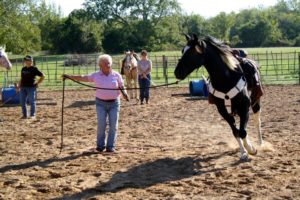
The Stevens friend, Cheryl has put a lot of work in, teaching Cisco how to lunge. (Photo by Amanda Stevens)
I can’t tell you how many horrible wrecks came from people who didn’t know how to canter. The problem is that when a horse spooks at something and needs to move his feet or gets excited and wants to catch up with another horse, they generally go into the motion of the canter or run. When that happens, and you don’t canter your horse regularly, the horse and you are going to be uncomfortable. The horse will feel your tightness, which is usually what leads to him to bucking and/or running off. Please take this column entry to heart. We write this with your safety in mind. Please take the time it takes. Even if you just spend that extra fifteen minutes I offered you in the beginning, you will be amazed how much your horse experience will change.
Ride your dreams,
Steve
HOME
Farm and Ranch Injuries
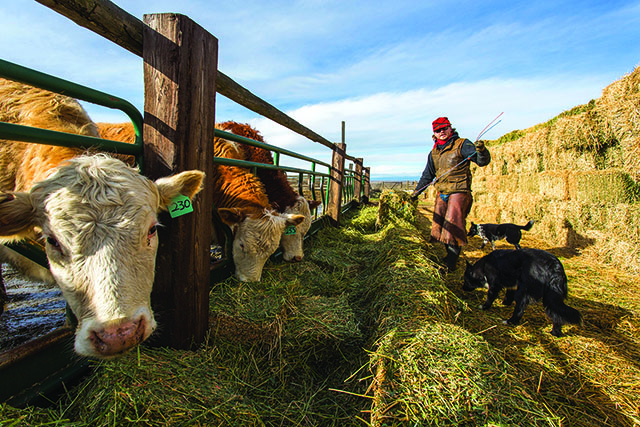
By Barry Whitworth, DVM
In January, I attended the Oklahoma Veterinary Conference. While waiting for one of the sessions to start, a classmate of mine commented how many of the attendees walk with a limp, used a cane, and/or have damaged hands. We all agreed that working with animals is hard on the body. In general, anything associated with farming and ranching is dangerous.
Most farmers and ranchers know that agriculture is a dangerous occupation. According to United States Bureau of Statistics, workers involved in agriculture, forestry, and fishing had the highest occupational fatality rate in 2022. The fatality rate of 23.5 per 100,000 full-time equivalent (FTE) workers for this group is much higher when compared to the overall occupation fatality rate of 3.7 per 100,000 FTE. Most of the agriculture-related fatalities are associated with transportation, such as tractor overturns, and vehicle crashes, but a fair number involve livestock.
To read more, pick up a copy of the March issue of NTFR magazine. To subscribe by mail, call 940-872-5922.
HOME
Jesses Jewelz

By Jesse Kader
Comfy and keep it western. That’s the name of the game this month. It’s hot and who wants clingy clothing? This jumpsuit is perfectly comfortable and relaxed without forfeiting the fashion. Dress it up or keep it casual. See this and more at www.jessesjewelz.com.
HOME
Noble Research Institute Expands New Program Offering Farmers and Ranchers the Essentials of Regenerative Ranch Management
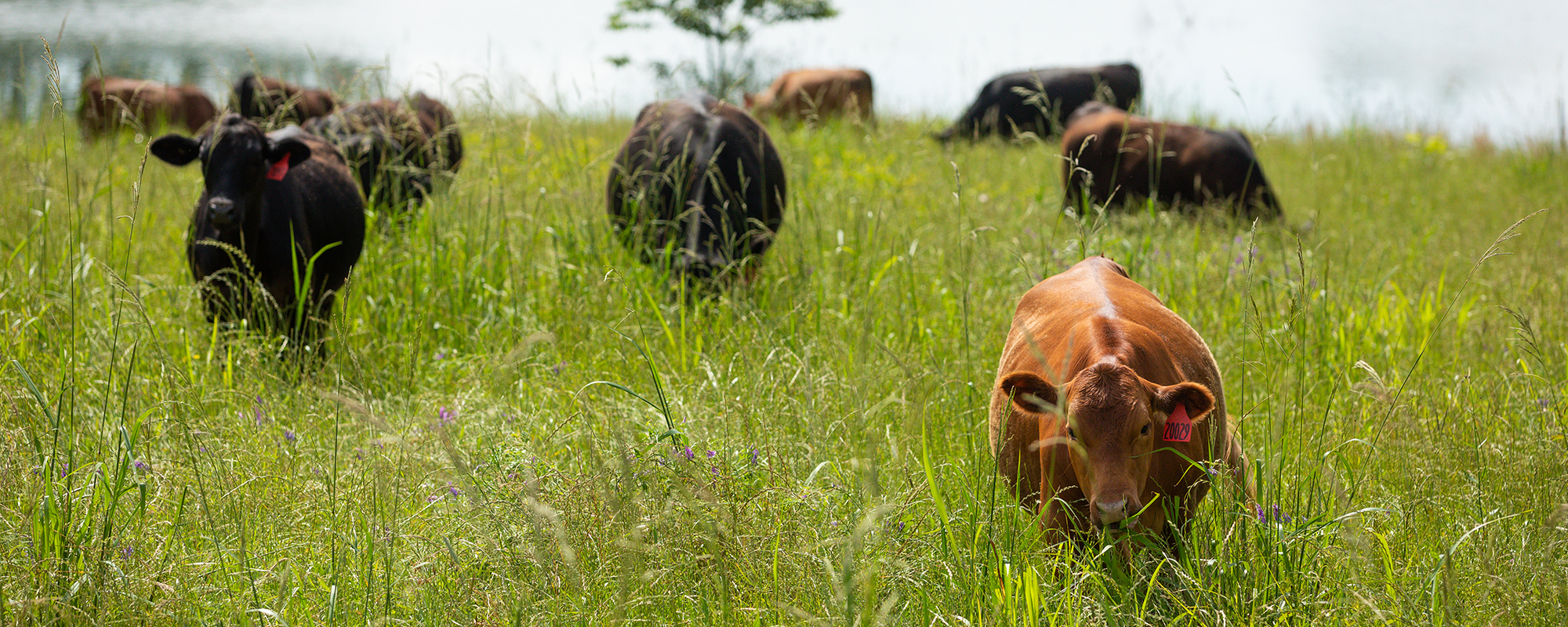
The educational program has been expanded to three new locations, empowering ranchers and farmers to monitor and improve the health of their land, livestock and livelihood through regenerative principles.
ARDMORE, OK–September 12, 2023 – Noble Research Institute announced the expansion of Essentials of Regenerative Ranching, a new educational program designed to help ranchers enhance and restore the land, making it more resilient and reaching livestock grazing goals through regenerative management. Essentials of Regenerative Ranching provides producers with practical tools, hands-on experience and guidance to make data-driven decisions to decrease costs and improve profit.
The Essentials of Regenerative Ranching course has been expanded to three new locations in Texas and Oklahoma. Registration is open now at www.noble.org/essentials. Seating is limited, so early registration is recommended.
Texas A&M
College Station, Texas
October 17 – 18
O.D. Butler, Jr. Animal Science Complex
Noble Research Institute
Ardmore, Oklahoma
October 31 – November 1
Pavilion Center
Texas A&M
Kingsville, Texas
November 7-8
Caesar Kleberg Wildlife Center
“Program participants gain working knowledge and experience of monitoring and improving the health of their soil, grazing livestock more strategically and making informed financial decisions,” said Hugh Aljoe, Noble Research Institute’s director of ranches, outreach and partnerships. “We use a mix of classroom and field work to send producers home with the tools they need to begin making changes on their ranch.”
Farmers and ranchers navigate uncertainty from weather, fluctuating market prices and escalating costs of inputs. Many producers are seeking new tools that offer greater control and reduce their operational uncertainty. Through this course, ranchers and farmers will calculate their financial situations, determine initial stocking rates, carrying capacity and grazing goals.
“The course is well-suited for ranchers of all experience levels and all types and sizes of operations,” Aljoe added. “No matter your situation, this program will transform the way you think about your ranch.”
The Essentials of Regenerative Ranching program allows producers to overcome obstacles, become more informed problem-solvers and increase the productivity of their grazing lands. By participating in this program, ranchers join a community of like-minded producers who are shaping the future of ranching and leaving a lasting impact on their land and families. “If I had known what I learned in this course when I started my regenerative journey, I could have avoided some key mistakes,” said Tana McCarter, a rancher, and Essentials attendee. “I left with the tools I needed to monitor my soil health and financial progress. I’ll now have the right data to make informed decisions on how to meet my regenerative goals.”
Noble Research Institute is an independent nonprofit agricultural research organization dedicated to guiding farmers and ranchers in applying regenerative principles that yield healthier soil, more productive grazing land, and business success.
At Noble, researchers, facilitators and ranch staff work together to share with farmers and ranchers the skills and tools to regenerate the land in a profitable manner. Noble is focused on the regenerative management of the nation’s grazing acres, which directly impacts pasture and range environments, wildlife, pecan production, and livestock production. Regenerative management recognizes that each decision made on the ranch impacts the interactions of the soil, plants, water, animals, economics and people. Noble’s 14,000 acres of working ranch lands provide a living laboratory on which to demonstrate and practice regenerative principles and ideas to deliver value to farmers and ranchers across the U.S.
-

 Country Lifestyles1 year ago
Country Lifestyles1 year agoScott & Stacey Schumacher: A Growth Mindset
-

 Equine7 months ago
Equine7 months agoThe Will to Win
-

 Country Lifestyles7 years ago
Country Lifestyles7 years agoStyle Your Profile – What your style cowboy hat says about you and new trends in 2017
-

 Country Lifestyles4 years ago
Country Lifestyles4 years agoAmber Crawford, Breakaway Roper
-

 HOME7 years ago
HOME7 years agoGrazing North Texas – Wilman Lovegrass
-

 Country Lifestyles7 years ago
Country Lifestyles7 years agoDecember 2016 Profile, Rusty Riddle – The Riddle Way
-

 Country Lifestyles8 years ago
Country Lifestyles8 years agoJune 2016 Profile – The man behind the mic: Bob Tallman
-

 Country Lifestyles8 years ago
Country Lifestyles8 years agoCowboy Culture with Clay Reid – Being a Man






